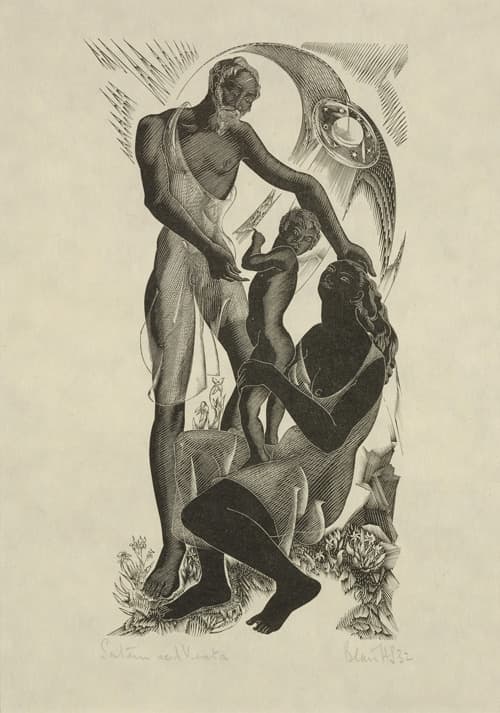
1. SONG
Look Nymphs, and Shepherds look,
What sudden blaze of majesty
Is that which we from hence descry
Too divine to be mistook:
This is she
To whom our vows and wishes bend,
Heer our solemn search hath end.
Fame that her high worth to raise,
Seem’d erst so lavish and profuse,
We may justly now accuse
Of detraction from her praise,
Less then half we find exprest,
Envy bid conceal the rest.
Mark what radiant state she spreds,
In circle round her shining throne,
Shooting her beams like silver threds,
This this is she alone,
Sitting like a Goddes bright,
In the center of her light….
Biography
Blair Hughes-Stanton was born in London in 1902. Between 1919 and 1924 he studied at The Byam Shaw Art School, The Royal Academy Schools and at The Leon Underwood School of Painting and Sculpture. Although an accomplished painter, he excelled as a wood-engraver and became one of the most significant book illustrators and designers of the 1920’s and 30’s. Blair Hughes-Stanton specialised in the illustration and the production of illustrated books for small scale publishers such as The Golden Cockerel Press, The Cresset Press, The Greynog Press and his own Gemini Press. He counted D.H. Lawrence among his friends and made engravings for several of his works. Following the Second World War during which he became a prisoner of war and was severely wounded, he moved to Manningtree and taught at The Colchester School of Art, St Martin’s and later for many years at the Central. In later life, lino-engravings became his preferred method of printmaking. Blair Hughes-Stanton died in 1981. The Minories Art Gallery in Colchester organised a retrospective exhibition of his works in 1984.
Statement
‘Four Poems’ by John Milton was published in October 1933, a month after Blair Hughes-Stanton had been forced to leave The Gregynog Press in Wales, where he had worked as artist in residence for more than three years. He had completed the work in January of that year. The poems, namely ‘L’Allegro’, ‘Il Penseroso’, ‘Arcades’ and ‘Lycidas’ were chosen principally as a vehicle for the engravings, presumably by the artist himself. The Calvinist owners of the press, the Davies sisters, had tried before, and failed, to ‘get him away from his elongated females’, but Hughes-Stanton was by then firmly established as a leading engraver and arguably at the height of his powers, so they had to let him have his head. The exuberant images of frolicking nymphs and shepherds, especially in the seven ‘Pastoral’ pieces, are almost certainly a celebration of the unconventional, unrestrained and soon to be unfettered love affair between the artist and the poet Ida Graves. These engravings which come from ‘Four Poems’ by John Milton were published by The Gregynog Press in 1933 in an edition of only 250 copies. The images were printed separately in editions of only 12.
Bibliography
- Hughes-Stanton, Penelope, Wood Engravings of Blair Hughes-Stanton, Private Libraries Association, 1991
- Gertrude Hermes & Blair Hughes-Stanton, exhibition catalogue, Ashmoleum Museum, University of Oxford, Oxford,1995
- Milton, John, Four Poems, Gregynog Press, Newtown, Montgomeryshire, 1933
Penelope Hughes-Stanton







